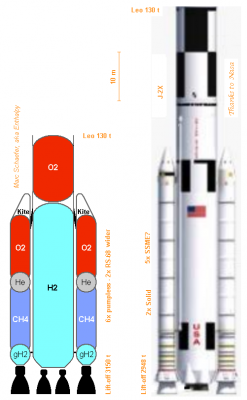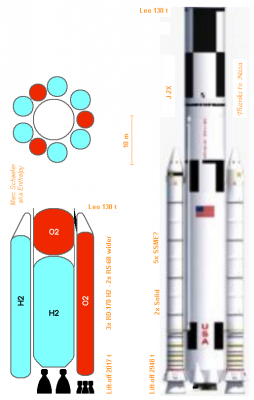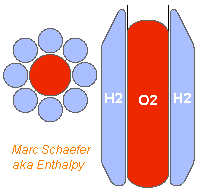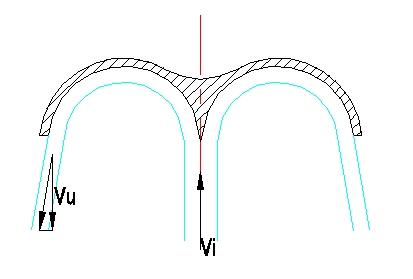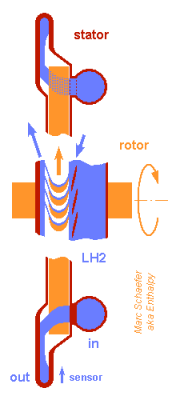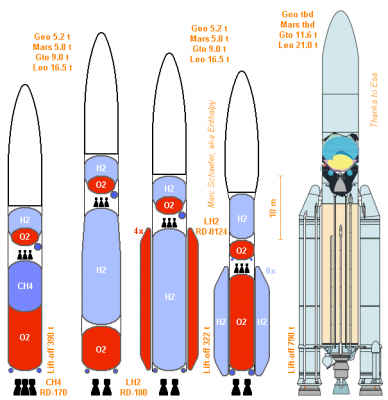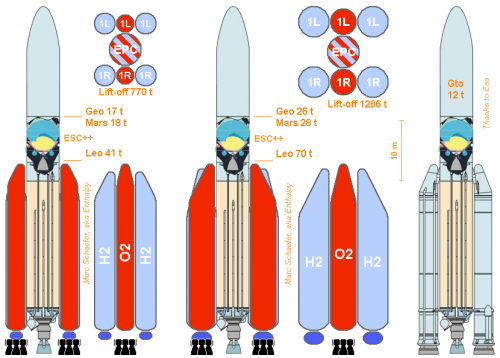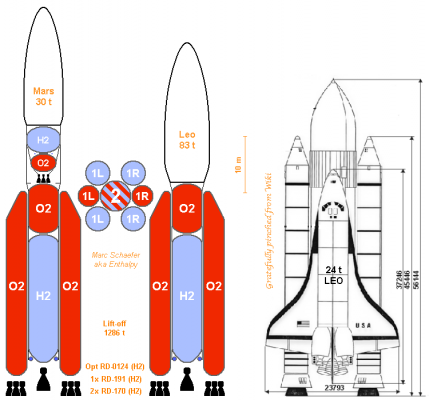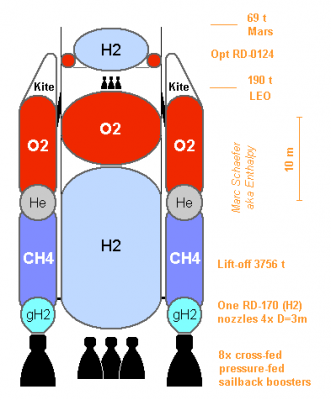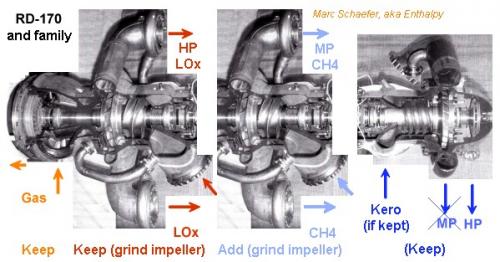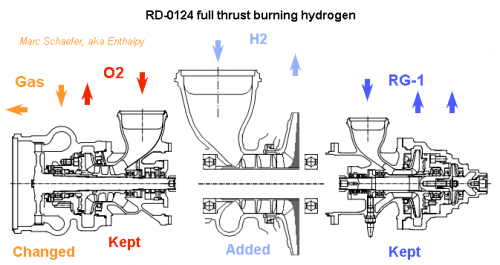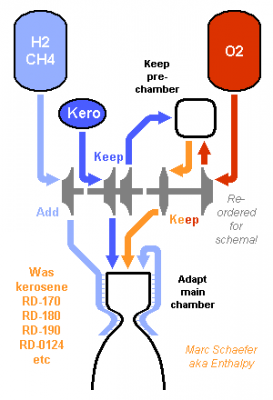-
Posts
3887 -
Joined
-
Last visited
-
Days Won
1
Everything posted by Enthalpy
-
You already read this, I suppose? http://en.wikipedia.org/wiki/Sand_casting they give an example of sand composition. From a friend's experience, an important condition is to dry completely the sand mould before pouring the liquid metal. After few seconds on Google, I've seen many pages giving such information.
-
Rubbia's design needs plutonium to start and to work (and I believe all do). It can't use an other nuclide to obtain the reactivity. But it produces only 233U, no plutonium. So it needs a present-day uranium reactor to supply plutonium, or rather, if you put figures on it, 10 uranium reactors for one Rubbia thorium reactor. And then you can replace this one Rubbia reactor with a classical uranium one, run with plutonium, and if you like, add thorium instead of uranium. Same benefit, no investment. http://www.iaea.org/inisnkm/nkm/aws/fnss/abstracts/abst_29022018.html http://www.iaea.org/inisnkm/nkm/aws/fnss/fulltext/29022018.pdf
-
Filtering 4nm won't be easy... Do you want to keep the rest of the colloid? It looks simpler if you can evaporate the liquid, evaporate or burn the surfactant, and melt the powder left behind.
-
To illustrate why I dislike solid boosters, here are variants of the evolved version putting 130 t into Low-Earth-Orbit. All variants have liquid boosters, whose better performance permit to scrap completely the upper stage, and all have only two cheaper RS-68 at the D=8.4m central stage instead of five expensive SSME. This one has six pressure-fed methane boosters, easy to develop; put less or more of them to adjust the performance. Additionally, I want them to splash gently into the Ocean and sail back home for re-use, as I explain there http://saposjoint.ne...php?f=66&t=2554 for which the thick-wall, all-welded steel construction is an advantage. (click to view full-size) With four pumped kerosene engines, model RD-170 (not made locally up to now, serious drawback). Upgrade capability is even bigger here. And here the three RD-170 burn hydrogen after some modifications explained there http://saposjoint.ne...start=40#p33694 Unusually, each RD-170 pushes three tanks side-by-side, and only the oxygen tank is built strong to lift the central stage by its top. Marc Schaefer, aka Enthalpy
-
20 years is a long duration, because technology evolves. Even space technology does. 20 years ago home PC's were uncommon, tunnel microscopes and hi-temperature superconductors were new, as were fullerenes and nanotubes; graphene and prions had not been discovered; genetic engineering was absent. When the Shuttle was developed, graphite composites were not usable, stereolithography neither - just as examples - and the Soviet kerosene engines couldn't be purchased. Technology built 20 years ago hence developed 30 years ago is difficult to operate, because the physical support for information (5"1/4 floppies) has changed, because materials and processes have changed, standards as well... The team who discovered the Pioneer anomaly testified about it. Understanding even older objects, like the Fukushima power plants or some war ships, is archaeotechnology. With this is mind, I'd prefer development to be faster, not service to be longer. But putting goals 20 years ahead is just a synonym of "never". Or better, you may hope some technology developed for this fuzzy goal will serve other projects - which must be Nasa's intents. - Assembling small parts into a big craft is made by humans up to now (please feel free to improve that). Over 100 manned flights, you're sure to lose one crew. And each manned flight is extremely expensive. - Some big parts are difficult to assemble in orbit. I wouldn't assemble a re-entry heat shield for instance: too unreliable. Or a habitat for one year on Mars, which has a minimum size, is heavy even if empty, and is too unreliable if assembled in orbit. - 100 "small" launches cost a lot. ISS needed launchers not really small.
-

Mechanical gas separation for post-combustion CO2 capture
Enthalpy replied to Wilmot McCutchen's topic in Classical Physics
Not everyone, sure. But if I put ideas on the Internet for someone, other people read them and make other uses of them. Suggesting expensive methods, that are used for uranium enrichment, but are far worse than the existing methods already used for CO2 scrubbing, makes me wary. Existing published technology shouldn't be secret, sure. But I have no intention to improve that particular technology. It is done presently and is affordable. Rather cheaper than separating the dioxide after combustion. Sequestration makes electricity produced with coal more expensive, but still far cheaper than nuclear or wind energy - it could stay cheaper than gas without sequestration. Proven and accessible coal reserves can replace oil and gas and still supply the whole Mankind for 1-2 centuries, so it can be a transition to the next source, with sequestration. Not the solution I dream of, but an affordable and available one. -
I explain there why Rubbia's thorium breeder can't run without 10* more uranium reactors, hence would use little of the available thorium, and is dangerous and polluting: http://saposjoint.ne...php?f=66&t=2026 shorter version: http://saposjoint.ne...php?f=66&t=2761 and then any uranium reactor, run with plutonium and some thorium, is just as good for this task as a specially-built reactor. Tokamaks not only induce radioactivity through the produced neutrons. They need tritium, which isn't available naturally and uranium reactors can't produce in usable quantity, so a tokamak (or any D-T fusion reactor) has to produce its own tritium from lithium. Because this needs to multiply neutrons, the process is very polluting, as much as a uranium reactor. Explanations there http://saposjoint.ne...php?f=66&t=2450 especially rationale with some figures there http://saposjoint.ne...6&t=2450#p32310 My bet is that tokamaks will be the very last to produce usable net energy, after the Z-striction, the magnetized target fusion, maybe laser fusion achieve it - and, yes, all will be very late, much later than our need stop emitting carbon dioxide, and far after we have renewable energy. Marc Schaefer, aka Enthalpy
-
Hi CaptainPanic and all, thanks for your interest! The extra thrust was unexpected indeed. It doesn't come from more ejected mass, as the oxygen throughput is kept in the best case, and O2:RG1:H2 mass ratio is 1000:28:167 instead of the initial O2:RG1 mass ratio of 1000:427. It comes from the greater ejection speed, like 4023m/s instead of 3305m/s for the RD-170 keeping the nozzle exit area. Hydrogen engines are much more efficient but more difficult, and the strongest existing today (RS-68) pushes 3MN, though it is meant for first stages (Atlas V). The possibility to convert an existing kerosene engine enables new performance: for instance, an Ariane 5 with two RD-170 boosters at maximum lift-off mass would put 50t into low Earth orbit, but 70t with hydrogen. An other example goes to geostationary orbit in two stages, which would be very bad with kerosene. As well, all highest-exhaust-speed hydrogen engines today use an expansion cycle that lets them push 100kN (RL-10, RD-0146...) and soon 180kN (Vinci); staged combustion as opposed doesn't limit thrust and the RD-0124 for instance would push 300kN with a similar exhaust speed. Staged combustion provides better performance among the powerful engines because all of one propellant passes through the turbine, not just a derived fraction of the propellants, and this achieves a higher chamber pressure. Oxygen-rich is the only way to burn properly a hydrocarbon prior to the turbine, as this turbine limits the temperature and impose very detuned mixtures; very fuel-rich would let soot even methane, and this soot is lost for combustion. Fuel-rich is usable and used with hydrogen. Adapting hydrogen engines to methane produced disappointing results, I believe for this very reason. Now, if the goal is a hydrogen-oxygen engine: - A fuel-rich pre-chamber achieves about the same performance. This is by chance, as many parameters differ: the amount of propellant passing the turbine, the volume of propellants pumped to the huge pre-chamber pressure, the worse efficiency of the hydrogen pumps and turbines. - Oxygen-rich brings fire risk at the materials, but hydrogen-rich needs huge turbine and pump speeds, despite using several stages. - Kerosene engines exist already and are cheap, even for 8MN, hence my interest in converting them to more efficient fuels through limited modifications.
-
I believe to understand - but may be wrong - that in a white dwarf, electron density is bigger than in an atom. It would be the case as soon as matter is denser than a solid. So the nucleus wouldn't really be isolated from the electrons; it's rather that one couldn't tell "this electron belongs to this nucleus". A nucleus stripped from all electrons doesn't occur naturally on Earth, and happens only to light nuclei in normal stars. They are produced for ion accelerators for instance. Little uses to happen to such stripped nuclei, but at least one exception is known: beta radioactivity (one neutron transforms into a proton and an electron) can accelerate a lot then, because the electron can jump to a low orbital of the atom, as this orbital is vacant. This shortens and lowers the energy barrier the electron has to tunnel through. It's one rare example where humans can influence radioactivity. Sonoluminescence has been reported to influence the rate of electron capture radioactivity, but I believe this hasn't been confirmed.
-
Hi Iñigo and everyone! In the other thread, "Higher combined propellants density" only compares with straight hydrogen+oxygen. With this reference, the few % kerosene gain few % density, and the added tank can fit in unused room. But if referring to a dense propellant like kerosene, density is clearly less good, and is very near to normal hydrogen+oxygen or methane+oxygen, sure. Isp is much more important than density for space rockets. Isp*density is used for missiles, where mass ratio is less important and volume is limited - and even then, this criterion is voluntarily biased by solid fuel suppliers to favour their junk. Isp*density is the N*s a fuel provides from a given tank volume, as if fuel mass were unimportant! Kerosene is used frequently on 2nd and 3rd stages, for instance by Soyuz, Zenit, Falcon-1 and Falcon-9... It offers an excellent blend of performance even for upper stages, but hydrogen is so seducing that it tempts everyone for upper stages, including Soyuz and Falcon. Hydrogen at a first stage is debated as it makes the launcher bulky, but tank mass isn't necessarily an obstacle - chosen for Delta IV. And imagine a stage like Proton: the smaller central oxygen tank could transmit the thrust to the upper stages, while lateral hydrogen tanks would only support themselves and be light. The sketched tanks are to scale. I'll put here as well some launcher designs. ------ Hot oxygen is a harsh environment for a turbine - not so much for the pre-chamber, which is actively cooled by liquid oxygen, including the injectors at the RD-170. This is what Google translates from Russian at Lpre.de about the RD-170: To eliminate the fire and destruction of parts of gas turbines tract, the design incorporates nickel alloys, including superalloys for the hot gas lines. The stator and the turbine exhaust tract forcibly cooled with cold oxygen. In places small radial clearance or end-uses various heat-resistant coating (nickel for rotor blades and stator, the rotor cermet), as well as silver or bronze items, excluding the fire even with a possible touch of rotating and stationary parts turbopump unit. So: the usual nickel superalloys, with a nickel or a ceramic coating. It certainly needed much experimental development, the reason why I like reusing this existing technology, but material cost looks reasonable - consistently with the RD-180's low cost: I've read figures like 10M$ for the original 4MN kerosene engine, as compared with 20-30M$ for a 3MN RS-68. A limited adaptation getting 8MN from an RD-170 with methane or hydrogen Isp is hence attractive. Marc Schaefer, aka Enthalpy -------------------------------------------------------------------------------------- A single impeller can pump hydrogen to 100 or 150b at once with common materials. The slow shaft of an oxygen-kerosene turbopump implies a big impeller, as on the sketch for the RD-0124. Maybe a hydrogen impeller adapted from the RS-68 would fit the smaller RD-191, but not the RD-170, which would have needed D=0.83m. Several stages would reduce the diameter but are just too sad for only 150b. I believe my Pelton-Schaefer pump :rolleyes :is a solution. Mentioned and later detailed there: http://saposjoint.ne...6&t=2272#p27829 on Fri Jul 16, 2010 http://saposjoint.ne...start=40#p33837 on Tue Aug 30, 2011 Just as a Pelton turbine, its blades run at V, and the liquid at nearly 0 and 2*V: http://en.wikipedia....ki/Pelton_wheel - other images at De and It wiki, the source of this one: which is the trick, because 150b with hydrogen need 2*V=650m/s and V=325m/s is easy for the wheel. As a Pelton turbine as well, the wheel is surrounded with gas or vapour, and a thin liquid film flows on the blades, fast but at low pressure. No bubbles need to collapse, and Pelton turbines last for years at 150b dynamic pressure. As opposed to a turbine, the pump takes liquid at small speed and pressure and accelerates it to 2*V, which is the sought overhead, converted into pressure by the discharge channel (the cut is through the blades near the centre of this sketch but equatorial elsewhere): the blades scoop liquid much like a spoon scoops ice cream or a chipping tool cuts material from a part. This allows also a big volume flow in a compact pump, more so with a booster pump. Like: D=0.38m for an RD-170, with 40mm blade height - easy fit on the original turbopump. This pump brings no throughput stability, that is, its volume flow is independent from the discharge pressure until goes mad. A fast active control must regulate the flow at the inlet. Marc Schaefer, aka Enthalpy -------------------------------------------------------------------------------------- A strong and efficient first stage opens new possibilities, for instance split the rocket performance to geostationary orbit (13600m/s) evenly between just two stages, with comfortable inert mass. (Click on the images to display at true size) As compared with the somewhat more capable Ariane 5, mass saved by the more efficient propellants lets bulky hydrogen look reasonable. The four configurations bring the same performance. Boring figures starting there http://saposjoint.ne...t=2272&start=60 if you like them. Now if a retrofit shall improve the performance of an existing launcher, sure it gets bulky: Unusual and looking odd: the hydrogen tanks are at the sides of the oxygen tanks. All are pushed by the engines, only the oxygen tanks transmit thrust to the central stage and the upper composite. I took 100kg tank mass per ton of propellants, but it's very pessimistic then. The left design keeps lift-off mass for compatibility, while the centre one makes good use of the two RD-170: 20t more to Leo than if burning kerosene. More payload using at the second stage an RD-191 modified for hydrogen: still compact despite hydrogen everywhere. Even more payload with an RD-170 at the second stage, modified for hydrogen: but this time the first stage burns methane and oxygen, pressure-fed from steel tanks, to save money. These are the sailback boosters I describe there: http://saposjoint.ne...php?f=66&t=2554 which shall be reused after splashdown in the Ocean. Marc Schaefer, aka Enthalpy
-
Methane and hydrogen are more bulky than kerosene, so the cycle achieves a main chamber pressure lower than the original. A new design would re-optimize all pressures and speeds but I want to keep most engine components, hence cycle adaptations are linked. One possibility keeps all pressure ratios and temperatures, which maintains the gas speeds and keeps the turbine and its speed untouched. As much energy is harvested by the turbine per kg of heated oxygen gas; pumping liquid oxygen to the lower pressure takes less energy which is invested in the extra fuel volume. Gas density hence mass flows scale down as the pressure, reducing the engine's power. Methane keeps 222b chamber pressure from 245b at the RD-170 burning kerosene: in vacuum, the specific impulse jumps to 3526m/s=360s for 7.24MN thrust kept, while sea level operation provides 3209m/s=327s and 6.59MN, all with the original four small nozzles. This holds for the RD-180 (nearly a half RD-170, with two chambers and nozzles instead of four). The RD-191 (quarter RD-170 with one chamber and nozzle) lets more easily widen the nozzle exit. Now if you look at the RD-170's turbopump, here carefully botched by myself: it comprises one part with the gas turbine and the oxygen pump, and an other part with the kerosene pump. Each has a complete shaft with bearings and seals and a casing, so we can separate them at the dry interface to insert the additional pump in between. Even better: the oxygen pump, which is designed for the same cold and volume flow, would pump lighter methane to the main chamber pressure . In fact, pressure from the original impeller must be slightly reduced, both at oxygen and methane, for which I'd just reduce the impellers' diameter with a grinding machine . It also needs a bearing and seals at the methane pump section, new injectors at the chamber, and a methane booster pump - that's about all! This is a small effort to gain 23s efficiency thanks to methane and enjoy a huge thrust. Marc Schaefer, aka Enthalpy -------------------------------------------------------------------------------------- The same parameters adaptation would work with hydrogen, keeping the turbine, but the low density would slash the pressure and thrust by a factor of 1.85, so sad. An other solution redesigns the turbine to extract more power from the gas expanding from the pre-chamber at original pressure to the main chamber at a lower pressure; more power allows a main chamber pressure reduced by 1.44 only, and the full pre-chamber operation keeps the full oxygen mass flow. Here's an example, this time with the smaller RD-0124 (Soyuz' improved third stage): again, the oxygen and kerosene sections have a clean dry interface where the additional pump section is inserted. The parts are approximately to scale: light hydrogen needs a larger impeller on this slow shaft, but its peripheral 540m/s are usual and its 0.26m diameter still reasonable. The hydrogen inlet and feeder are big to avoid a separate booster pump. The original four nozzles provide a big expansion for vacuum operation. With hydrogen at 109b, the adapted engine would boast 4382m/s=447s and 306kN: efficiency from the best hydrogen engines group, with more thrust, through a limited adaptation effort. Marc Schaefer, aka Enthalpy -------------------------------------------------------------------------------------- I go to bed, but will come back. With answers for Iñigo (¡Gracias por tu interés!), more engine descriptions, and examples of use at new launchers or for retrofit, including as side boosters for Ariane 5.
-
Hello you all! Some fabulous rocket engines exist already and use oxygen and kerosene in a staged combustion cycle (drawing), where all liquid oxygen is pumped to a huge pressure, burnt with little kerosene to achieve a reasonable temperature, passes through the turbine that moves the pumps, and burns the rest of the kerosene in a main chamber at high pressure. This most efficient cycle gives for instance the RD-170 its 8MN thrust (record) and 337s vacuum specific impulse (record with first-stage kerosene) and the RD-0124 its 359s specific impulse (record with kerosene). Better: the single slow turbo-pump makes cheap engines, and pressure makes them compact. http://www.lpre.de/e...D-170/index.htm http://www.lpre.de/k...-0124/index.htm http://en.wikipedia....le_%28rocket%29 The hard development (pre-chamber and turbine in hot oxygen!) is already done; adaptation to hydrogen or methane seems much easier than a new design, with the method I propose. I had first described it there, and with more explanations and examples of uses later http://saposjoint.ne...6&t=2272#p27786 http://saposjoint.ne...start=40#p33663 but the present topic attempts to be clearer and more concise. Essentially, I keep the oxygen pump, the pre-chamber, the turbine, the kerosene pump untouched or little modified and add a methane or hydrogen pump, in light blue on the schema: In the new operation, the main kerosene flow to the chamber is replaced by the hydrogen or methane flow. The bit of kerosene is kept at the pre-chamber because it works, but methane could reach the huge pressure in one pump step as well; some kerosene flow can be kept to the main chamber, in tiny amount if it stabilizes the flame there, or in big amounts if one builds a tri-propellant engine (like oxygen and first kerosene, then hydrogen, which shall ease a single-stage-to-orbit). Keeping some kerosene and its pump in addition to hydrogen or methane to may look complicated, but the parts already exist. A single stage hydrogen pump achieves the main chamber pressure, while the pre-chamber would require three stages with hydrogen. Existing hydrogen engines with staged combustion have a fuel-rich pre-chamber. This needs all the bulky hydrogen to be pumped to huge pressure and produces very fast hot gas, both needing a fast turbopump with several stages - this is easier with the oxygen-rich pre-chamber. Such hydrogen engines had been tried at methane and tri-propellant operation, but kerosene and methane soot in a fuel-rich pre-chamber, ruining the efficiency: oxygen-rich is better for them. Marc Schaefer, aka Enthalpy --------------------------------------------------------------------------------------
-

Carbon Nanotube Spring: The Best Foreseeable Battery?
Enthalpy replied to MrMormon's topic in Engineering
It's always the same story with nanotube strength. When you take a narrow filament, it's incredibly strong - be it a carbon nanotube, a steel whisker or a polyester fibre. But as soon as we put many of them together to make a rope or some part of usable size, strength has nothing to do with the observations at microscopic scale. As for the many supposed advantages of a spring made of nanotubes: this is sheer speculation. Until a several thousand have been built and tested, we completely ignore how they behave. Forecasting their performance is completely out of reach of any kind of science. And for the applications: nobody knows neither. Partly because we ignore the performance sizeable parts will have, partly because a single person cannot invent many uses, less so invent both a material and its uses. -
Under low pressure AND at extreme heat, like 3000K, H2 dissociates into H in significant proportion, like 10...70%. Only tungsten withstands such a temperature for a significant time without sublimating. That's an excellent reason not to use hydrogen. Other elements are much more easily atomized and have a magnetic moment, for instance potassium gas, maybe mercury, zinc, cadmium... Simpler: some molecules have a magnetic moment. Oxygen O2 is famous for it. That's because it has two non-paired electrons. http://en.wikipedia.org/wiki/Triplet_oxygen pyrolytic graphite also reacts to fields without being ferromagnetic. All these single atoms or small molecules react weakly to magnetic fields. If you desire important effects, you need a ferromagnetic solid, where the collective behaviour of many atoms collaborate.
-
Cu++ has a nice blue colour like in azurite http://en.wikipedia.org/wiki/Azurite precipitates I saw have this colour but not as dark and intense. Cu+ is green like in malachite http://en.wikipedia.org/wiki/Malachite Electrolyse salts but not dissolve the electrodes is difficult. Apart from gold, platinum and a few more... you can use graphite, which makes the central electrode of a banal zinc battery (the non-alkaline 1.5V elements). When opening an element, beware the liquid chemicals in it: protect your eyes, have water at hand. Better avoid it with an alkaline battery, it contains KOH.
-
Solutions or mixtures of cyclobutane, cubane and boctane, or of two of them, may keep high performance and improve the liquid range. Especially when cubane becomes affordable. Marc Schaefer, aka Enthalpy
-
Self-quoting Enthalpy: "Mimicking the brain on a computer has been attempted so many times" Yes it has. I helped a colleague in 1985 who was doing such things and they weren't new at that time. Certainly not a single neuron. Newspapers don't take the time to study a topic before reporting about it, but you can do it.
-

Mechanical gas separation for post-combustion CO2 capture
Enthalpy replied to Wilmot McCutchen's topic in Classical Physics
What you describe with hidden words is the presently standard method for isotope separation, especially for uranium enrichment, and the second-standard method. And, sorry, I won't help you in that way. -
http://en.wikipedia.org/wiki/Alkane Wiki is the first place where to look. It's too often the last one, though it shouldn't.
-
What a hype! Mimicking the brain on a computer has been attempted so many times, including on the biggest supercomputers, and on specialized machines... Is there any paper around here that tells what could make this project different from the previous and ongoing ones? From what I read they use banal processors as everyone does. In big quantity, mutitasked, and with a connection network - again as every big computer. They tried to contain the power consumption through the choice of the processors, as has been done before as well, and doesn't change so much. To the very least, what is the connexion network they use? I mean, the electronics network between the processors - not the synapses they want to emulate.
-
It needs some hardware, but... Melt your aluminium, make droplets at an injector in a high-speed non-oxidizing gas like argon or hydrogen. Very fine powder, fast production. Next difficulty: how to avoid any contact with air, or it goes boom.
-
Distillation is commonly used as the economical way to produce magnesium. Heat is needed anyway when reducing the metal from its ore. Differential electrolysis is the way copper and aluminium are produced from the ores. Zinc and the easily oxidized elements stay in the bath, copper deposits on the electrodes. But I "doubt" electrolysis would be used on metals already reduced. Common alloys are very much recycled, and production methods tell "introduce the recycled metal here" and "put the new metal there". When a factory uses copper or nickel, it separates its garbage from steel; when valuable steel is used in big quantities, its garbage is separated from unalloyed steel as it resells better. Same for plastics, if big quantities are used and produce garbage. But at the consumer's garbage bin, alloys are less sorted.
-
Avoid permanganates and chlorates, as their pressure exponent exceeding 1 lets them detonate instead of burn as needed in a rocket. Available hydrogen peroxide is very dilute and unusable. Excellent, because any usable concentration makes peroxide very dangerous.
-

questions about electroplating copper to aluminum
Enthalpy replied to fshegg3's topic in Applied Chemistry
Not exactly the answers you expected, sorry for that... If I got it right you want to cover aluminium with a metal layer that can be soldered. Electroplated nickel does that; it's very common and affordable, including on aluminium, and is hugely more durable than copper. You'll get less contact corrosion of aluminium than with copper, and an excellent protection of aluminium. Ask your plating contractor if some catalytic nickel (then with low phosphorus?) does it. Over nickel, plating contractors can also deposit tin or similar, and then soldering gets really easy. Don't plate with silver, gold, palladium and the like, as they dissolve in solder. Anyway, this is a complete profession, which cannot be learnt in few months. Soldering is one excellent option; the other is thermal grease, as used for electronics. It needs permanent pressure, which solder doesn't. Screws. Nowadays, when people want to spread heat over distance, they use heat pipes (see Wiki). You'll find them in ready-to-use coolers for CPU and video cards in computers, cheap. Keep the whole cooler: this would be the normal way now that they're mass-produced, instead of making one by yourself. Some are passive, if you dislike the fan. Newegg, eBay... Peltier elements use to be stacked in pyramids because each element provides a small temperature difference, and since their efficiency is very bad, the next-warmer element must be much larger than the previous one. The complete stack can have 0.1% efficiency. If you can, the standard refrigerator method is far better; usable and ready hardware is available to sub-cool CPU's for overclocking - ask at http://www.tomshardware.co.uk for instance. -

Electroplating silver onto chromium surface.. help?
Enthalpy replied to shsy's topic in Applied Chemistry
Somehow I imagine the spontaneous chromium oxide layer hampers electroplating, and this should improve with nickel, yes. Why electroplating silver? There are autocatalytic processes that deposit nice brilliant silver on any surface, like glass.


